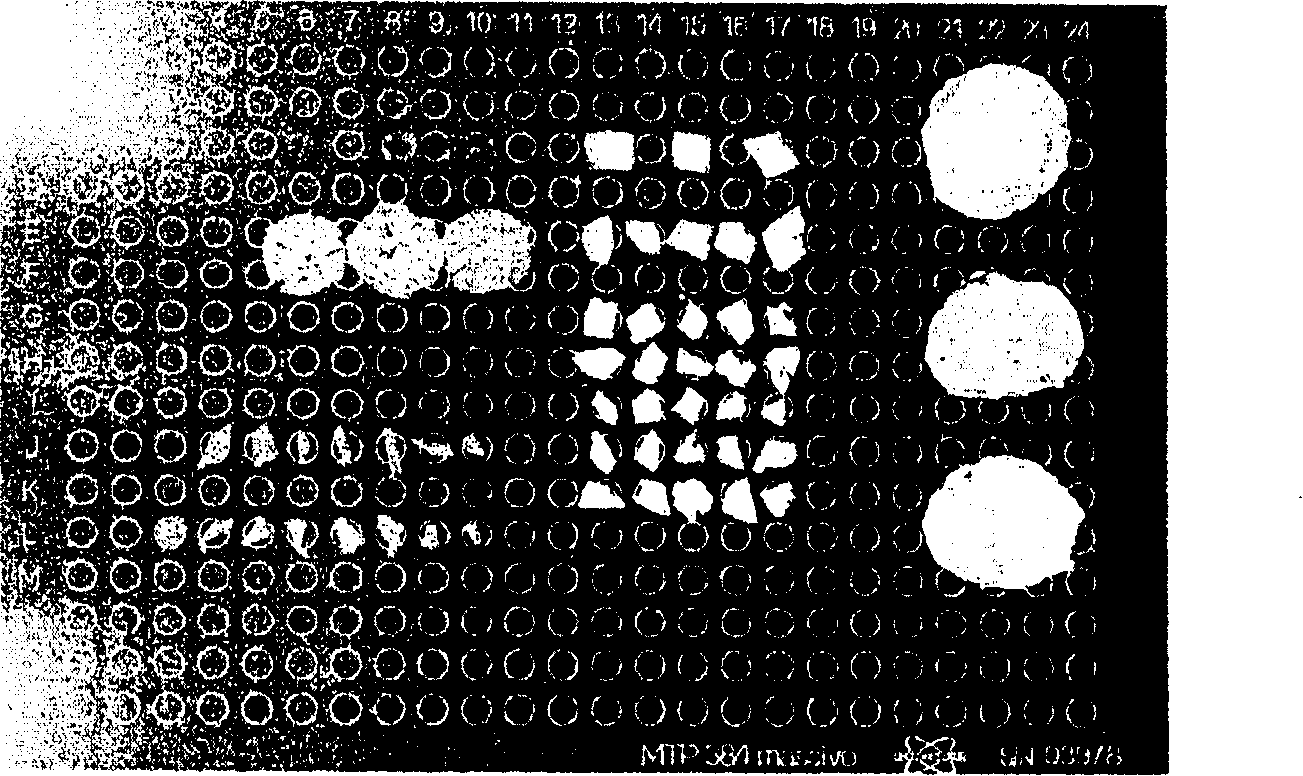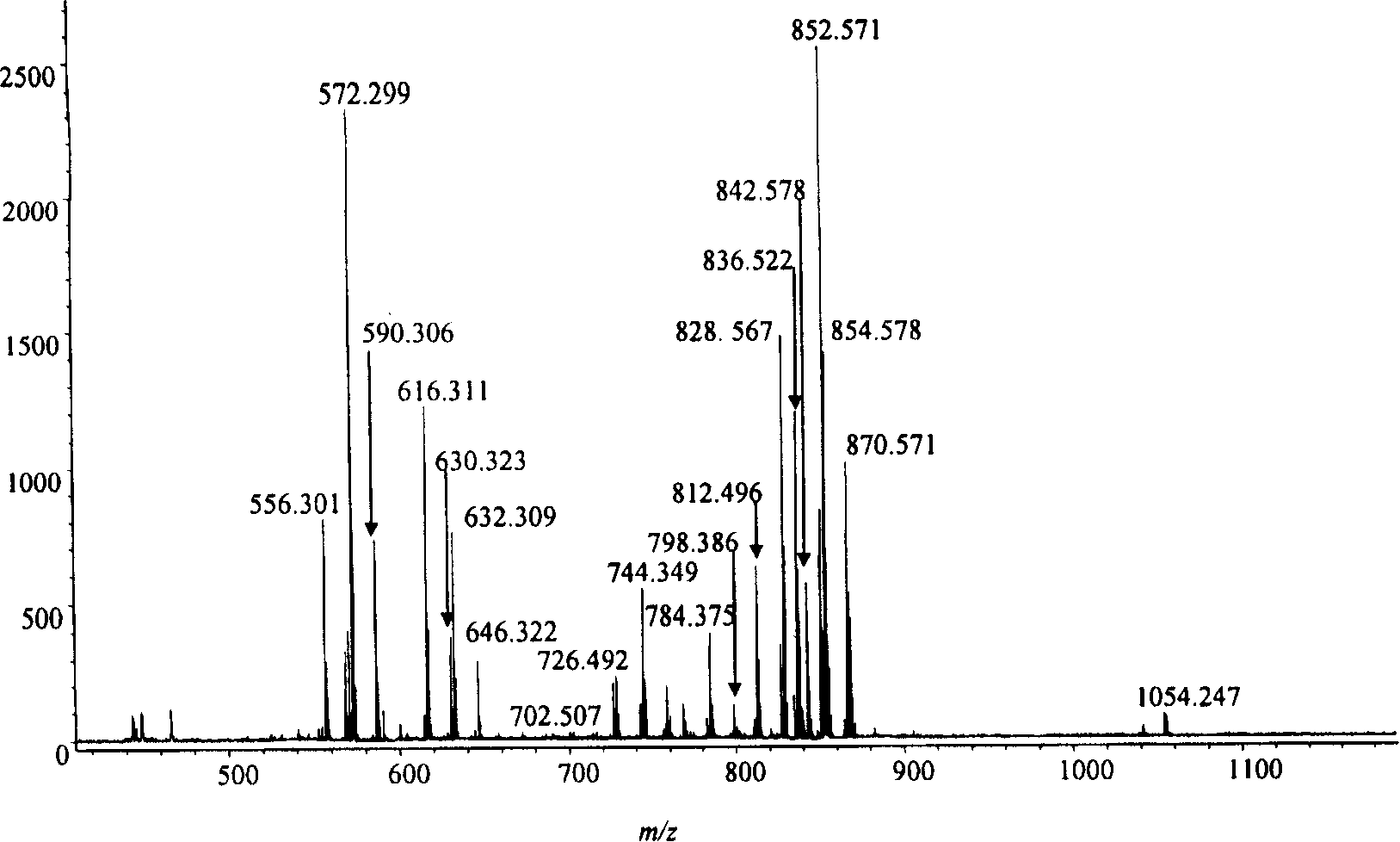Method for directly analyzing chemical composition of plant tissue slice
A plant tissue and chemical composition technology, applied in the analysis of materials, material analysis by electromagnetic means, scientific instruments, etc., can solve the problems of cumbersome identification process, large demand for samples, difficult identification and analysis, etc., to achieve high sensitivity and reduce analysis. cost, effect of avoiding extraction steps
- Summary
- Abstract
- Description
- Claims
- Application Information
AI Technical Summary
Problems solved by technology
Method used
Image
Examples
Embodiment 1
[0022] Select 1 Chuanwu and soak it in water for 10 minutes. Cut the plants into 10-20 μm thick slices with a microtome. Put it on the target of matrix-assisted laser desorption ionization-time-of-flight mass spectrometer (MALDI-TOF-MS), such as figure 1 shown. Freshly prepare the matrix solution before the experiment: acetonitrile / 0.1% trifluoroacetic acid (50:50) and α-cyano-4-hydroxycinnamic acid (CHCA, α-cyano-4-hydroxycinnamic acid) to make a saturated solution (~30mg / ml) spare. Add the matrix solution to the plant tissue slices with a pipette at a volume of about 30 μl / cm 2 . After the matrix solution is spotted on the tissue section, the target is placed in a vacuum desiccator and dried for measurement. Use matrix-assisted laser desorption ionization-time-of-flight mass spectrometer (MALDI-TOF-MS) for direct measurement, try to use smaller laser energy during the measurement process, such as 9-13μJ, select 10 points clockwise on the slice, each Each point is coll...
Embodiment 2
[0024] Take 1 Aconitum aconitum and soak it in water for 10 minutes. Cut the plants into 10-20 μm thick slices with a microtome. Put it on the target of matrix-assisted laser desorption ionization-time-of-flight mass spectrometer (MALDI-TOF-MS), such as figure 1 shown. Freshly prepare the matrix solution before the experiment: acetonitrile / 0.1% trifluoroacetic acid (50:50) and α-cyano-4-hydroxycinnamic acid (CHCA, α-cyano-4-hydroxycinnamic acid) to make a saturated solution (~30mg / ml) spare. Use a pipette to add the matrix solution to the plant tissue section with an amount of about 30 μl / cm 2 . After the matrix solution is spotted on the tissue section, the target is placed in a vacuum desiccator and dried for measurement. Matrix-assisted laser desorption time-of-flight mass spectrometry (MALDI-TOF-MS) was used for direct measurement, and the smaller laser energy was used as much as possible during the measurement process. 10 points were selected clockwise on the slice,...
Embodiment 3
[0026] Select 1 Nuxychnium seed and soak it in water for 10 minutes. Cut the plants into 10-20 μm thick slices with a microtome. Put it on the target of matrix-assisted laser desorption ionization-time-of-flight mass spectrometer (MALDI-TOF-MS), such as figure 1shown. Freshly prepare the matrix solution before the experiment: acetonitrile / 0.1% trifluoroacetic acid (50:50) and α-cyano-4-hydroxycinnamic acid (CHCA, α-cyano-4-hydroxycinnamic acid) to make a saturated solution (~30mg / ml) spare. Use a pipette to add the matrix solution to the plant tissue section with an amount of about 30 μl / cm 2 . After the matrix solution is spotted on the tissue section, the target is placed in a vacuum desiccator and dried for measurement. Matrix-assisted laser desorption ionization-time-of-flight mass spectrometer (MALDI-TOF-MS) was used for direct measurement, and as little laser energy as possible was used in the measurement process. Select 10 points clockwise on the slice, collect 3...
PUM
 Login to View More
Login to View More Abstract
Description
Claims
Application Information
 Login to View More
Login to View More - R&D
- Intellectual Property
- Life Sciences
- Materials
- Tech Scout
- Unparalleled Data Quality
- Higher Quality Content
- 60% Fewer Hallucinations
Browse by: Latest US Patents, China's latest patents, Technical Efficacy Thesaurus, Application Domain, Technology Topic, Popular Technical Reports.
© 2025 PatSnap. All rights reserved.Legal|Privacy policy|Modern Slavery Act Transparency Statement|Sitemap|About US| Contact US: help@patsnap.com



